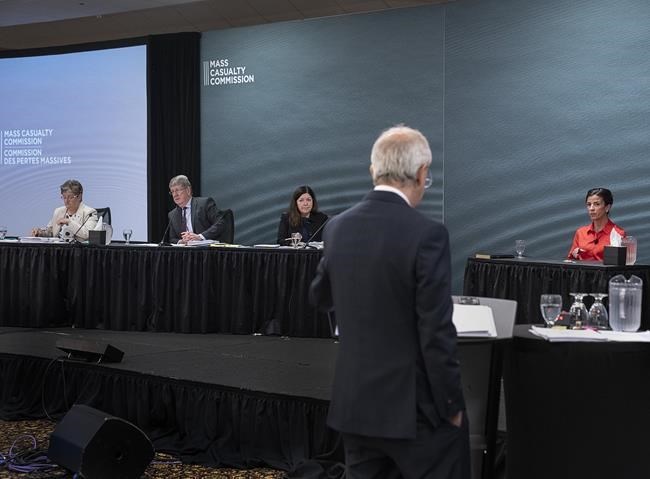
Commissioners Leanne Fitch, Michael MacDonald, chair, and Kim Stanton, left to right, observe as Lia Scanlan, director of strategic communications for the Nova Scotia RCMP, is questioned by counsel Roger Burrill at the Mass Casualty Commission inquiry into the mass murders in rural Nova Scotia on April 18/19, 2020, in Truro, N.S. on Wednesday, June 8, 2022. The inquiry investigating the Nova Scotia mass shooting has released new details about the Mounties' scramble to find an aircraft to track down the killer on the night of April 18, 2020. THE CANADIAN PRESS/Andrew Vaughan
June 09, 2022 - 12:37 PM
HALIFAX - The inquiry investigating the Nova Scotia mass shooting has released new details about the Mounties' scramble to find an aircraft to track down the killer on the night of April 18, 2020.
Documents released Thursday show RCMP commanders were beset by bureaucratic hurdles and muddled advice before they eventually found a helicopter. But the mission the next day was marred by technical glitches that left its crew one step behind the killer's progress.
Early in their 13-hour manhunt for the shooter, the Mounties requested the use of an RCMP helicopter. But it was grounded for maintenance, the inquiry has heard. Meanwhile, the RCMP's fixed-wing aircraft for the Atlantic region was also unavailable. Staff shortages stemming from COVID-19 restrictions had prolonged its annual maintenance in Moncton, N.B.
That bad news was confirmed to RCMP commanders at 11:16 p.m., just over an hour after a man disguised as a Mountie and driving a replica RCMP cruiser started killing neighbours and strangers in Portapique, N.S., about 130 kilometres north of Halifax.
In all, the killer fatally shot 13 people and set fire to several homes in the subdivision. He later escaped on a little-used back road. Early the next day, he resumed his rampage, murdering another nine people before he was shot dead by two Mounties at a gas station.
The inquiry has heard the Mounties wanted an aircraft with an infrared sensor that could pick up the heat signature of a human body because the suspect could have been hiding in one of the subdivision's dark, wooded lots.
Their first call was to the Joint Rescue Co-ordination Centre (JRCC) in Halifax, which handles military and coast guard search-and-rescue operations. But they hit a snag when the Mounties were told the JRCC's aircraft could not be deployed to look for an active shooter.
On a subsequent call, however, the Mounties learned the military could provide an aircraft, but the request had to go through official channels.
"That request has to go from the RCMP through the province to the federal government," an unidentified official is quoted as saying that night. "I know it sounds convoluted, but that’s just the only way we can do it."
The process was started but wasn't completed.
Meanwhile, the Mounties also looked into chartering a civilian aircraft or borrowing one from the federal Fisheries Department or Transport Canada. And there was talk about getting an RCMP aircraft from Montreal or Ontario. Again, those options did not pan out.
At 3:15 a.m., the RCMP asked Nova Scotia's Department of Lands and Forestry if one of the department's four helicopters was available, even though none of them was equipped with Forward-Looking Infrared Radar (FLIR).
Though a helicopter was available, it was restricted to flying in the daytime and could not take off before 6 a.m. With no other options, the Mounties made the arrangements.
With pilot Ken Corkum at the controls, the Airbus H125 helicopter arrived over Portapique at 8:47 a.m., according to a summary of evidence, known as a foundational document. Also aboard was an RCMP spotter.
Though the weather was clear, the mission did not go smoothly.
There was confusion over the use of radio channels. The Mounties wanted Corkum to use encrypted channels to ensure the killer couldn't monitor their messages. But Corkum was initially unaware his radio had that capability. And when he realized those channels were available, they didn't seem to work for him.
At 9:48 a.m., the RCMP received a 911 call from a couple in Glenholme, N.S., where the killer had just approached their home with a rifle in hand. After knocking on the door and ringing the doorbell, he left only two minutes later at 9:50 a.m.
Less than two minutes after that, Corkum was told of the sighting, but the RCMP officer who alerted him, Staff Sgt. Kevin Surette, had trouble relaying the co-ordinates when the pilot failed to respond. By 9:55 a.m., the helicopter was still 2.8 kilometres south of the home and the killer was gone.
Adding to the confusion was Surette's warning that the armed suspect was still in the house on the second floor.
"This information was incorrect," the document says. "It was the resident of the property, Adam Fisher, who was armed and present within the residence."
When more shootings were reported in nearby Debert, N.S., the helicopter arrived minutes later. But there was a series of radio problems, no sightings, and then it was time for a refuelling stop.
It was during that stopover that RCMP Const. Chad Morrison was wounded by the gunman in Shubenacadie, N.S.
By the time the helicopter arrived overhead at 11:13 a.m., the gunman had fatally shot Const. Heidi Stevenson and fled in a stolen car.
Corkum was told to fly south toward Milford, N.S., but he had to land in a farmer's field because the RCMP constable aboard was airsick.
The helicopter later arrived over a gas station in Enfield, N.S., one minute after the killer was shot dead at 11:26 a.m.
This report by The Canadian Press was first published June 9, 2022.
News from © The Canadian Press, 2022